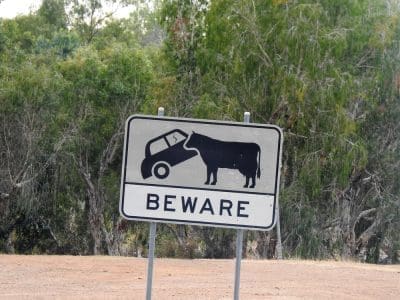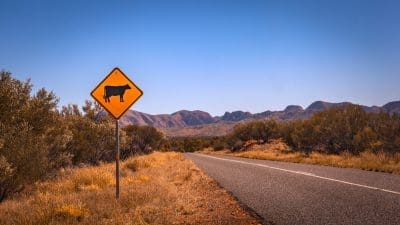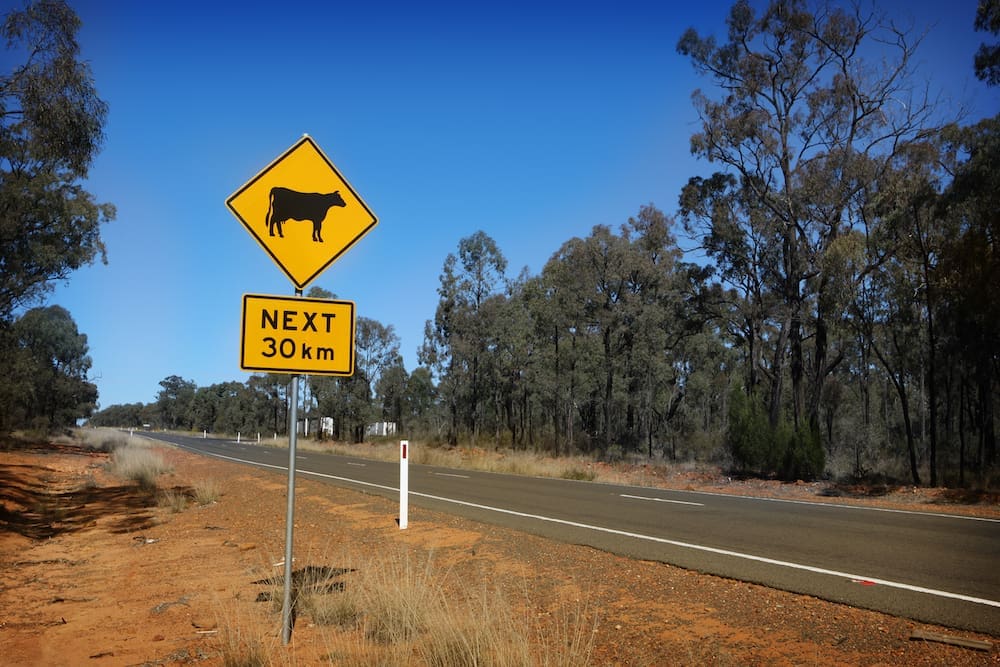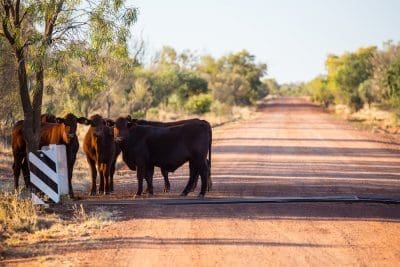A CATTLE farming couple in New Zealand was last month ordered to pay $273,000 after a truck collided with 17 of their black cattle which had strayed onto a busy highway on a dark night.
The truck’s owners took the cattle producers to court for damage caused to their vehicle, claiming the farmers were at fault because they had failed to properly secure their stock.
In their defence the farmers declined liability, claiming the steers had jumped over a boundary fence.
Their lawyers also told the court the truck driver, who was uninjured in the crash, was visually impaired, having lost an eye several years earlier, and had been driving above the speed limit and was talking on a mobile phone when the crash occurred.
After considering the evidence, which included feedback from experts as to whether cattle are physically capable of jumping fences (some believed yes, others no), the court ruled the farmers had breached their duty of care to adequately secure their cattle and ordered them to pay for $273,000 to the owners of the damaged truck and trailer.

Who is responsible?
The New Zealand case raises questions about who is liable for damages that result when vehicles collide with livestock that stray onto public roads in Australia.
From conversations we have had with people with knowledge of the issue, the indications are that most Australian States have laws which hold the owners of livestock legally liable in such circumstances.
The notable exception is Queensland, where an old English law which gives cattle the right of way over vehicles on public roads still holds sway (more below).
Pacific Highway accident
A similar case to the New Zealand incident occurred in New South Wales in 2016, in which a Gosford man was awarded over $1 million in relation to an accident which involved cattle straying onto the Pacific Highway.
The court heard the man rounded a blind bend on the highway when he encountered the cattle on the road. He applied his brakes to avoid hitting the stock but his car was hit from behind by a car towing a boat. The accident pushed his car into one of the cows, and the court was told he suffered head, neck and psychological injuries as a result of the accident.
The owner of the property from which the cows escaped did not admit liability.
Evidence tendered against the property owner included a letter from his local Council which confirmed his cattle had been seen on the highway previously, and he had been sent a letter just six days before the accident occurred, ordering him to fence his boundaries to an appropriate standard.
In handing down his ruling the judge said a reasonable person in the livestock owner’s position would have taken precautions against the risk and his negligence had led to the occurrence of harm.
The court ruled the driver of the car towing the boat was 35 percent responsible for the accident, and the owner of the cattle was 65 percent responsible (More details on that case here).
In Victoria, the State’s Department of Agriculture says livestock producers must ensure their animals do not wander onto roads where they can create a serious road safety issue. It also notes that local councils have the power to issue notices to confine stock and improve fencing to ensure it is sufficient to confine livestock.
Old ‘right of way’ law
Summaries of the status of these laws in Australia, such as this parliamentary research paper, indicate that for some years after mechanised transport began to appear more commonly on public roads in both England and Australia, livestock were deemed to have right of way over vehicles.
This common law rule was affirmed by the English House of Lords in 1947 in the case of “Searle v Wallbank’, in which the plaintiff was seriously injured when he was struck by a horse that had escaped from the defendant’s property.
Evidence was tendered that the fence surrounding the defendant’s property was dilapidated, and there were gaps through which an animal such as a horse might pass.
However, the House of Lords found that a landowner was under no duty of care to fence their property in order to avoid animals escaping.
The law had the effect that, as summarised in this Deakin Law Review article, “a landowner has no legal obligation to fence their property so as to avoid animals not known to be dangerous straying from the property, and so causing danger to road users and others”.
The original justification for the rule was that in early times of mechanised vehicles few roads were fenced off from adjoining land, and it was deemed that compelling livestock owners to prevent stock from straying was a considerable imposition. It was also taken that road users accepted the risks inherent in road travel, including the presence of straying animals.
The law was removed in England and all other Australian States in 1971, but not in Queensland. Since that time there have been various ultimately unsuccessful attempts by people who have suffered loss or damage to overturn the law.
The RACQ has previously called on the Queensland Government to investigate the most appropriate ways to frame new legislation that recognises both the impracticality of fencing all of Queensland’s extensive pastoral holdings, but enables road users who suffer personal injury or property damage caused by straying stock and arising out of proven negligence of the stockowner to be entitled to fair compensation from the owner.
Any change in law should also take into account the need for road users to exercise all reasonable care when travelling in remote areas where properties are unlikely to be fenced, the RACQ said.

It also suggested the Queensland Government consider the relevant Western Australian legislation, which it says gives courts the power to decide liability under the general laws of negligence, but also place a cap on liability.
It is also worth noting that in contrast to prevailaing State legislation local council by-laws can also hold landholders responsible for confinding livestock.
As one example the Gladstone Regional Council states that livestock owners are bound by law to provide proper enclosures and to prevent animals from wandering or escaping, and straying can be impounded by the council and released only after payment of set fees.
The Queensland Law Reform Commission brief written in 2010 suggested that if Queensland does move to change the law in future, any proposal should consider competing rural and urban interests, comprehensive road traffic statistics on motor vehicle accidents involving livestock, and research into the costs of fencing and of public liability insurance.
- Please note that the information contained in this article does not in any way constitute, and must not be relied upon, as legal advice, and readers are advised to seek advice specific to their circumstances.



Stray beast run into my Ute travelling on the Great North Hwy 90 ks out of Newman wrote my vechiel off .caused serious exspence to continue road trip to Perth over 2 days for medical treatment for regional patients ..Ute’s value only 10000 but lm a 82 pensioner with a disa bility walk assisted on a walking Frame .. had a carer/ driver assistance .taking vechiel to Perth for assessment to fit disabled controls to my vehicle ..Also have a simulated driving Tests to drive ..driver was cleared of any negligence road side the typical drug and alcohol ..both zero ….lm seeking damage for loss of vechiel..
This is an interesting situation.
The “rule” Searle v Walbank serves to protect the owners of ” tame” livestock that wander onto the road, citing there is no obligation to fence or maintain fencing.
It does not cover animals deliberately put on the road.
In an ongoing discussion about gates and grids across public roads with my LGA Rockhampton Regional Council, I was informed gates exist on unfenced Council roads with less than 30 cars a day because there is no legal onus on landowners to fence their parcels of land out of the road reserve and it was unreasonable to expect landowners to bear the cost of fencing.
The Sealve v Walbank ruled was cited.
In Australia a Statute takes precedence over Common law if both are about the same thing.
Qld Land Act cites ” depastureing stock or causing stock to be depastured on State Land without authority is Trespass.
Permits to graze can only be issued by the State under strict guidelines, short term and only in times or hardship.
The presence of stock on Queensland roads (State Lands) in LGA’s that allow gates and grids across public roads automatically infers these animals will be ” depastured” as a result of the LGA issuing permits for the gate or grid ( prescribed activity, the structure only).
The LGA in allowing gates and grids in lieu of fencing is then complicit in the act of grazing on State Land.
The ” same thing” is domestic animals on the roads Whether stock straying on to the road, or landowners who use gates and grids to negate the need to fence, isn’t it still the criminal offence of Trespass to depasture stock on State Land without a permit.
I had a similar experience in New Zealand when one of my cows escaped through a new fence I had just completed . A cow escaped through the fence which had become damaged probably after 2 cows were fighting. The insurance company tried to make me pay for the damage to the car. I told them of the new fence etc. and reminded them that cars are required to stop within half the distance of the clear road in front of them Obviously their driver did not. They dropped the case 🙂
Travelling a Hwy at night under gazetted speed (100km/h) to hopefully stop before hitting a cow is more likely to result in being hit by a truck.
The time for your eyes to adjust following approaching headlights and foot to apply full brakes is further than you can see a cow on low beam.
Hitting a cow nearly killed me, but the police and owner say it was my fault, truck drivers say cars should be banned on the Hwy at night.
Is Qld parliament full of transport or cattle barons…?
hi just wondering i lost couple bulls almost a week ago and couldnt find them now im worried whart happens if someone hits 1 or both them who is responsable and what if worse happens ive gone out for about 5 to 6 hours a day to find them im not sure if someone has shot them and i cant see were they have walked or hear them anywere so what would happen to me if god forbid happens
Animals are unpredictable no one can be liable for their actions.
Our CTP insurance must cover all injuries to driver’s and passenger’s without faults.
Karen Hinds. If you were driving at 90kms/h around a blind bend towing a trailer, thank god it was a cow and not a person on the road. At some stage drivers need to be held responsible for their driving. Rule is you should only travel at a speed at which you can stop within your line of sight.
Good after noon,
I was driving fro Darwin to Perth and 120ks out from fitzroy crossing i hit a cow . i came around a bend and it was. On my side of the road facing the car. I had know time to stop. I was traveling at 90ks due to having a traier and 2 motorbikes. My jeep is possibly a write off. Im back in Perth, it got towed to Fitzroy. Now i have no jeep, no transport and a huge bill to transport it😢😢. Can you please give me some advice to whether i can legally make a claim.
Regards
Karen Hinds
What was reply to the unfortunate person who hit the cow travelling to Darwin near Fitsroy Crossing WA ..wrote off his car and trailer had to claim to wage exspences lve had a similar experience please Reply ASAP thank you
I just hit a calf on Sandgate Rd* beside Big Dads Pies at 330 am last Thursday morning that escaped from Nudgee College. My car will be probably written off. And I have to pay the $810 excess. This is in the city. I’ve been told it isn’t the college’s fault for not securing the properly. And I might be liable for the cost of the calf. Is this true? thanks
* Editor’s note: Nudgee Colllege is a boy’s boarding school along Sandgate Road, on Brisbane’s northside. The college maintains its own cattle herd on surrounding land, and a Cattle Club program for students
Proponents wanting to change the law in Qld do so for reason of self interest. I found the side of a cow one night riding a motor bike. I learned a very important lesson don’t go to sleep riding on the road. No insurance claim made. I have traveled many a km since at night just don’t do it tired. When some one puts their hand up taking responsibility for all wild life that contributes to road accidents then cattle, sheep and any other live stock are just another animal on the road. If you drive take responsibility for your own safety and insure yourself for the unavoidable. You can always stay at home and be safe.
Only in Qld & NT is a grazier not responsible for cattle being on road/other states are different though.
Are owners of cattle reponsible for damages caused by cattle on a public road which goes through their private property?
I think unless the farmer who owns the stock can be proven careless and irrisponsible that lifestock should be treated the same as wildlife. If the paddock has a standing fence with a water supply and feed the farmers can’t be held liable. I own cattle so my opinion my be bias but a fence for cattle is only a guide line, If they get it in their heads that they want out they will. These creatures have a mind of their own and exercise free will. Another point I think is worth considering is the production of cattle is consumer driven so does that also mean that the general public should be held responsible. ?
Who would have thought cattle can jump fences, HA HA. Do we now have to build them 8ft high and full electric and then who decides they are stock proof.
A common sense approach needs to be taken. Stock constantly straying on a road and the landowner is liable.
Stock straying onto a road unexpectedly and there should be no liability.
An unfenced road should be signposted.
I am not sure in other states but in Queensland neither the state nor the local government will share costs in fencing a property where it joins the state or local government property.
Unfortunately as rural landowners are now at the bottom of the social food chain when it comes to politics, expect in the future something absurd to be bought in.
Also if a tree on public land falls on your fence and stock wander onto the road , who is liable then , especially when you have asked for these trees to be removed?
Who do you sue ,when you run into wildlife on country roads. Do we hold the State and Federal government’s to blame .